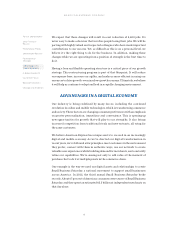American Express 2012 Annual Report Download - page 20
Download and view the complete annual report
Please find page 20 of the 2012 American Express annual report below. You can navigate through the pages in the report by either clicking on the pages listed below, or by using the keyword search tool below to find specific information within the annual report.AMERICAN EXPRESS COMPANY
2012 FINANCIAL REVIEW
CRITICAL ACCOUNTING ESTIMATES
Refer to Note 1 to the Consolidated Financial Statements for a
summary of the Company’s significant accounting policies
referenced, as applicable, to other financial statement footnotes.
Certain of the Company’s accounting policies that require
significant management assumptions and judgments are set forth
below.
RESERVES FOR CARDMEMBER LOSSES
Reserves for cardmember losses represent management’s best
estimate of the probable losses inherent in the Company’s
outstanding portfolio of cardmember loans and receivables, as of
the balance sheet date.
In estimating these losses management uses statistical models
that take into account several factors, including loss migration
rates, historical losses and recoveries, portfolio specific risk
indicators, current risk management initiatives and
concentration of credit risk. Management also considers other
external environmental factors in establishing reserves for
cardmember losses.
The process of estimating these reserves requires a high degree
of judgment. To the extent historical credit experience updated
for external environmental trends is not indicative of future
performance, actual losses could differ significantly from
management’s judgments and expectations, resulting in either
higher or lower future provisions for cardmember losses.
As of December 31, 2012, an increase (decrease) in write-offs
equivalent to 20 basis points of cardmember loans and
receivables balances at such date would increase (decrease) the
provision for cardmember losses by approximately $215 million.
This sensitivity analysis is provided as a hypothetical scenario to
assess the sensitivity of the provision for cardmember losses. It
does not represent management’s expectations for write-offs in
the future, nor does it include how other portfolio factors such as
loss migration rates or recoveries, or the amount of outstanding
balances, may impact the level of reserves for cardmember losses
and the corresponding impact on the provision for cardmember
losses.
LIABILITY FOR MEMBERSHIP REWARDS EXPENSE
The Membership Rewards program is the largest card-based
rewards program in the industry. Eligible cardmembers can earn
points for purchases charged on most of the Company’s card
products. Certain types of purchases allow cardmembers to also
earn bonus points. Membership Rewards points are redeemable
for a broad variety of rewards including travel, entertainment,
retail certificates and merchandise. Points typically do not expire
and there is no limit on the number of points a cardmember may
earn.
The Company records a Membership Rewards liability that
represents the estimated cost of points earned that are expected
to be redeemed. The liability reflects management’s judgment
regarding ultimate redemptions and associated redemption costs.
Management uses statistical and actuarial models to estimate
ultimate redemption rates of points earned to date by current
cardmembers based on redemption trends of current enrollees,
card product type, enrollment tenure, card spend levels and
credit attributes. A weighted-average cost per point redeemed
during the previous twelve months, adjusted as appropriate for
recent changes in redemption costs, including mix of rewards
redeemed, is used to estimate redemption costs. Management
periodically evaluates its liability estimation process and
assumptions based on developments in redemption patterns,
cost per point redeemed, partner contract changes and other
factors.
The liability for the estimated cost of earned points expected to
be redeemed is impacted over time by enrollment levels, points
earned and redeemed, and the weighted-average cost per point,
which is influenced by redemption choices made by
cardmembers, reward offerings by partners and other
Membership Rewards program changes.
Changes in the URR and weighted-average cost per point have
the effect of either increasing or decreasing the liability through
the current period marketing, promotion, rewards and
cardmember services expense by an amount estimated to cover
the cost of all points previously earned but not yet redeemed by
current enrollees as of the end of the reporting period. As of
December 31, 2012, an increase in the estimated URR of current
enrollees of 100 basis points would increase the balance sheet
liability and corresponding expense for the cost of Membership
Rewards by approximately $270 million. Similarly, an increase in
the weighted-average cost (WAC) per point of 1 basis point
would increase the balance sheet liability and corresponding
expense for the cost of Membership Rewards by approximately
$80 million.
FAIR VALUE MEASUREMENT
The Company holds investment securities and derivative
instruments that are carried at fair value on the Consolidated
Balance Sheets. Management makes assumptions and judgments
when estimating the fair values of these financial instruments.
In accordance with fair value measurement and disclosure
guidance, the objective of a fair value measurement is to
determine the price that would be received to sell an asset or paid
to transfer a liability in an orderly transaction between market
participants at the measurement date based on the principal or,
in the absence of a principal, most advantageous market for the
specific asset or liability. The disclosure guidance establishes a
three-level hierarchy of inputs to valuation techniques used to
measure fair value. The fair value hierarchy gives the highest
priority to the measurement of fair value based on unadjusted
quoted prices in active markets for identical assets or liabilities
(Level 1), followed by the measurement of fair value based on
pricing models with significant observable inputs (Level 2), with
the lowest priority given to the measurement of fair value based
on pricing models with significant unobservable inputs (Level 3).
The Company does not have any Level 3 assets measured on a
recurring basis. Refer to Note 3 to the Consolidated Financial
Statements.
18
























